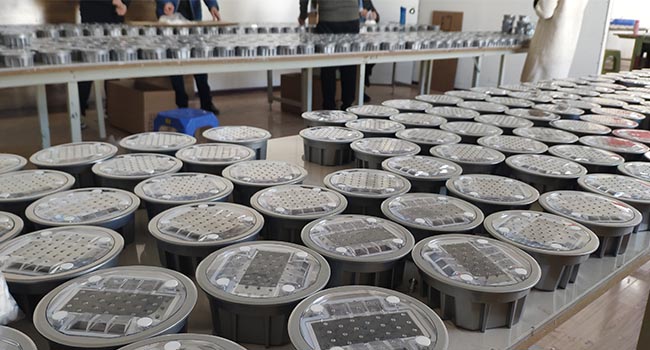Solar Road Stud Selection Guide
In low-visibility conditions such as nighttime, rain, fog, or dust storms, solar road studs provide clear road boundary and lane separation guidance for drivers through their active illumination properties, significantly reducing traffic accident rates. Whether on highways, urban thoroughfares, scenic routes, or rural roads, high-quality solar road studs are indispensable traffic safety infrastructure.
However, the market offers a wide range of solar road stud products with significant variations in performance—including pressure resistance, brightness, and battery life. Choosing the right product ensures safety benefits, while selecting the wrong one may lead to frequent malfunctions and render them ineffective. This article breaks down the selection logic for solar road studs across three dimensions—types, core performance, and purchasing details—helping you avoid pitfalls and make precise selections.

Two Core Categories of Solar Road Studs
The type of solar road stud directly determines its applicable scenarios. First, narrow down the category based on the installation environment and usage requirements, then refine your selection to significantly improve purchasing efficiency.
By Installation Position: Flush-Mounted vs. Raised
Flush-mounted solar road studs sit level with the road surface, offering the key advantage of not interfering with vehicle traffic and being resistant to damage fromcrushing. This makes them ideal for high-pressure environments like highway centerlines and urban thoroughfares. However, installation requires trenching, resulting in slightly higher construction costs compared to raised types.
Raised solar road studs protrude 5-20mm above the road surface and feature active illumination. They offer easy installation and long-range visibility, making them ideal for road edge lines, ramps, rural roads, and parking lots. However, they require strong compression resistance to withstand damage from heavy vehicles.
By Energy Storage Component: Capacitor-Based vs Battery-Based
Capacitor-type solar road studs utilize super capacitors as their core energy storage, supporting over 500,000 charge/discharge cycles with a lifespan of 5-8 years. Though higher in cost, they offer exceptional endurance stability, making them ideal for demanding environments like frigid regions.
Battery-type solar road studs utilize lithium-ion or nickel-metal hydride batteries for energy storage, supporting approximately 100,000 charge/discharge cycles with a lifespan of 3-5 years. Their moderate cost and cost-effectiveness make them the most widely adopted type, suitable for most scenarios including ordinary roads and scenic routes. Currently, protruding battery-type solar road studs account for over 80% of the market share.
|
Classification Dimension |
Type |
Key Features |
Cost Level |
Applicable Scenarios |
|
Installation Position |
Embedded Type |
Flush with the road surface; no protrusion |
High construction cost |
Highway centerlines, urban main roads (high load-bearing requirement) |
|
Installation Position |
Raised Type |
Protrudes 5–20 mm above road surface; active illumination |
Low construction cost |
Road edges, ramps, rural roads, parking lots |
|
Energy Storage Element |
Capacitor Type |
Supercapacitor energy storage; stable discharge |
Relatively high |
Cold regions; scenarios requiring highly stable endurance |
|
Energy Storage Element |
Battery Type |
Lithium-ion / NiMH battery storage |
Medium |
General roads, scenic routes (most widely used option) |
Core Performance Metrics for Solar Road Studs
The safety assurance capability of solar road studs relies entirely on their core performance. The following four metrics are “must-check items” during selection. Strict adherence to industry standards is required to avoid performance shortfalls that compromise effectiveness.
Compressive Strength
Frequent vehicle traffic, especially heavy truck crushing, directly tests the structural integrity of solar road studs. This is the fundamental threshold for their long-term road durability. The compressive strength of solar road studs must be ≥10 tons, meaning they can withstand the weight of a 10-ton heavy vehicle without damage. To meet this standard, high-quality products utilize PC bulletproof material for the outer shell, paired with a thickened shell design. Internally, they employ an IC integrated control module to reduce component loosening, further enhancing overall compressive resistance.
When selecting products, avoid those with plastic casings or shell thicknesses <5mm. Such products are highly prone to cracking or detaching under heavy vehicle pressure, failing to meet long-term usage requirements.
Sealing Performance
Exposed to outdoor conditions, solar road studs face risks from rain, dew, or melted snow/ice infiltrating their interiors. This can cause circuit short-circuits and component damage, making sealing performance their “lifeline” for waterproofing and moisture resistance.

High-quality solar road studs must achieve an IP67 or higher sealing rating. This means complete dust resistance and the ability to withstand 30 minutes of submersion in 1 meter of water without leakage. To achieve this level of sealing, reputable products employ a “housing + internal circuitry” split-seal design. Seams are bonded with high-strength neutral adhesive instead of ordinary glue, preventing bonding failure in extreme temperatures. When purchasing, proactively ask vendors for “immersion test reports.” Authoritative testing verifies the product's reliable operation during severe rain and snow conditions.
Brightness
The core function of solar road studs is to provide guidance through illumination. Insufficient brightness fails to penetrate low-visibility conditions like rain and fog, thereby compromising safety. Solar road stud brightness is strictly regulated: luminous intensity must ≥2000 MCD, with visibility ≥300 meters. Premium products incorporate 3-6 high-brightness LED chips paired with reflector cup designs to enhance light concentration, ensuring clear visibility for drivers even in heavy rain or dense fog.
When purchasing, be wary of products with “inflated brightness claims.” Request third-party brightness test reports from suppliers or inspect actual illuminated samples to ensure brightness meets operational requirements.
Stability
Solar road studs must operate outdoors long-term, with stability directly impacting lifespan and maintenance costs. This stability manifests in three key areas: battery, circuitry, and endurance. Battery Stability Lithium batteries must feature charge/discharge protection and operate within a temperature range of -40°C to +65°C to withstand extreme cold and heat. High-quality batteries support ≥100,000 charge cycles and last over three years.
Circuit stability requires waterproof and corrosion-resistant circuit board designs, branded components, and precise soldering to prevent failures from vibration or moisture. Battery endurance demands that after 8 hours of full sunlight charging, the product can continuously illuminate for over 72 hours, ensuring reliable operation during cloudy or rainy weather without unexpected power interruptions.
Bonus Selection Criteria for Solar Road Studs
Beyond core performance metrics, these three details further refine your selection of premium products, helping you avoid subpar options while ensuring a reliable user experience.
Product Certifications
Legitimate solar road studs must carry relevant authoritative certifications. These certifications directly validate compliance with industry standards and environmental requirements, serving as an “authoritative endorsement” of quality. Key certifications include CE certification (EU safety standards), ROHS certification (environmental standards ensuring no heavy metals or other harmful substances), and domestic transportation product certifications like CCPC. Products with these certifications undergo strict quality control during production, offering greater assurance in performance and environmental compliance. This effectively prevents purchasing counterfeit or substandard products, reducing usage risks.

Brand and Reputation
Premium brands excel in product quality control and after-sales service, offering significant advantages that minimize future hassles—essentially providing an “invisible guarantee” for post-purchase support. When selecting products, opt for brands with over three years of industry experience. Such brands possess extensive production expertise and technological know-how, ensuring more consistent product quality. Additionally, assess brand reputation by reviewing user feedback and examining real-world applications, such as whether the product has been deployed in major highway projects. Additionally, pay close attention to after-sales service details. Key considerations include:
Product warranty period (premium products typically offer ≥2 years)
Response time for fault repairs
Availability of on-site installation guidance
Comprehensive after-sales support ensures greater peace of mind during use.
Price and Cost-Effectiveness
Solar stud prices vary based on material, performance, and brand, creating a range of options. Standard raised solar studs tend to be slightly lower in price, while embedded and capacitive models carry a higher unit cost. When selecting products, avoid falling into the “low-price trap.” Do not blindly pursue low prices, as excessively low costs often indicate compromised materials and substandard performance. Such products not only have a short lifespan but may also increase maintenance costs due to frequent failures and potentially pose safety hazards. Conversely, avoid blindly favoring high-priced options. Evaluate cost-effectiveness by balancing core factors like “compression resistance + sealing integrity + brightness + stability + warranty coverage.” Selecting products that meet performance standards ensures long-term reliability.
The core of selecting solar road studs lies in “first determining the type suitable for the scenario, then focusing on performance to establish a baseline, and finally relying on details to screen for high-quality options.” Identify the suitable type based on the installation location and energy storage method. Ensure the product meets the core safety thresholds of pressure resistance ≥10 tons, sealing IP67+, brightness ≥2000 MCD, and endurance ≥72 hours to meet safety thresholds. Combine this with authoritative certifications, reputable brands, and reasonable cost-effectiveness for final selection. This approach ensures you choose products that meet road requirements, offer long-term stability and durability, and truly fulfill their role as safety guides in low-visibility scenarios, safeguarding travel.




